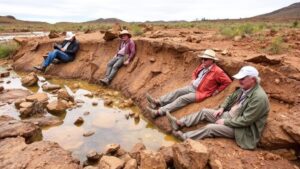How California’s Merced River Became a Popular Gold Sluicing Location
How California’s Merced River Became a Popular Gold Sluicing Location
The Merced River, flowing through the Sierra Nevada mountain range in California, has a rich and storied history tied closely to the Gold Rush of the mid-19th century. The river not only provided natural beauty and essential resources but also became a key site for gold sluicing. This article delves into the geological, historical, and social factors that contributed to the rise of the Merced River as a popular location for gold sluicing, a method that significantly impacted Californias economy and settlement patterns.
The Geological Context
Geologically, the Merced River is situated in an area abundant in gold deposits, primarily because of its proximity to granitic bedrock. This bedrock, formed from cooled magma, erodes over time, releasing tiny particles of gold into the river. The rivers flow has created alluvial deposits, where heavier materials like gold tend to settle. The combination of these geological features made the Merced River a prime location for gold panning and sluicing.
To better understand the conditions for gold accumulation, it’s important to note the significance of hydraulic mining techniques, which were often utilized in conjunction with sluicing. According to historical data from the California Geological Survey, the mining activities led to the extraction of millions of dollars worth of gold, with estimates suggesting that the total amount taken from the Sierra foothills during the Gold Rush was approximately $2 billion in todays currency.
The Gold Rush Era
The California Gold Rush, starting in 1848, transformed not only the Merced River region but also the entire state. The discovery of gold at Sutters Mill in nearby Coloma led to a massive influx of miners, entrepreneurs, and settlers seeking fortune. By 1850, the population of California had surged to over 90,000, with many locating themselves near the Merced River, drawn by its potential wealth.
- In 1852 alone, records indicate that $60 million worth of gold was extracted from California rivers, including the Merced.
- The establishment of mining camps and towns, such as Mariposa and Yosemite Valley, facilitated the growth of the local economy.
Techniques of Gold Sluicing
Sluicing is a method that uses a sloped box, known as a sluice box, to separate gold from other materials in river sediment. Miners placed the sluice box in water, allowing the current to wash lighter material away while retaining heavier gold particles. This technique was particularly advantageous in the fast-flowing waters of the Merced River.
During the Gold Rush, numerous innovations emerged in sluicing technology, including the development of multi-tiered sluice boxes, which increased efficiency in gold recovery. The use of mercury amalgamation and further mechanical enhancements allowed miners to maximize their yield effectively.
The Socio-Economic Impact
The gold found in the Merced River and its tributaries had a profound effect on the regions development. influx of miners led to a growing demand for goods and services, spurring economic growth. Towns such as Mariposa and Merced became key supply centers by providing tools, food, and provisions to miners.
Also, the success of gold sluicing attracted various immigrant groups, including the Chinese, who arrived with their own mining techniques. The competition for resources, however, sometimes resulted in conflict among different cultural communities and contributed to the socio-economic tensions in the region.
Contemporary Implications
Today, Californias legacy of gold mining is preserved through various historical sites and state parks that honor the contributions of early miners and the impact of the Gold Rush. Merced River continues to attract recreational gold panners, and it serves as a significant example of the environmental and cultural effects of mining activities on Californias landscape.
Plus, ongoing discussions surround sustainable practices in recreational mining, reflecting lessons learned from the environmental degradation caused during the Gold Rush. The government currently regulates gold mining activities to mitigate adverse impacts on the river ecosystem.
Conclusion
The Merced Rivers journey into the annals of gold sluicing history is a compelling narrative woven with geological advantages, human ambition, and socio-economic transformation. By understanding the multifaceted dynamics that led to its popularity during the Gold Rush, it becomes evident how natural resources and human endeavor intersected to shape Californias history. For modern enthusiasts, responsible gold panning in these historic waterways not only connects them with the past but also emphasizes the importance of sustainable practices in preserving this natural treasure.
Actionable Takeaways
- For those interested in recreational gold panning, it is important to research local regulations to ensure sustainable practices.
- Understanding the history of the Merced River can provide deeper insight into California’s socio-economic development and environmental policies.
- Visiting historical mining sites and participating in guided tours can enhance appreciation for the regions rich history and heritage.



